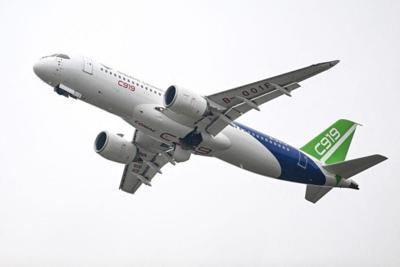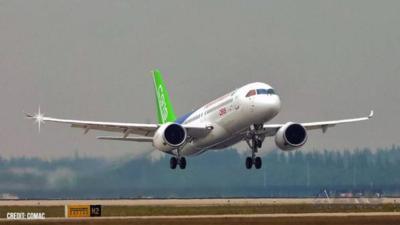GallopAir Signs LOI for $2-Billion Deal
Brunei-based airline GallopAir intends to purchase thirty C919 narrow-body aircraft from Chinese plane-maker Commercial Aircraft Corporation of China (COMAC). The inchoate sale occasions the first overseas purchase of the Chinese state-owned airframer’s controversial jet, which is broadly believed to instantiate myriad instances of industrial espionage perpetrated against Western aircraft OEMs the likes of Boeing and Airbus.

GallopAir set forth in a September 2023 statement that it had signed a Letter Of Intent (LOI) with COMAC establishing the air-carrier’s intention to purchase 15 COMAC ARJ21 aircraft, to include freighter and business jet variants, and 15 C919 airliners, which compete, ostensibly, with Boeing’s 737 MAX and Airbus’s A320neo jets. The deal is reportedly worth approximately $2-billion.
The deal was disclosed by China-based Shaanxi Tianju Investment Group, an investor—not surprisingly—in GallopAir.
GallopAir further stated the COMAC aircraft, prior to delivery, will be required to undergo due diligence and certification processes mandated by Brunei's Department of Civil Aviation.
"Flight operations are forecasted to begin in the third quarter of 2024;” so averred GallopAir.

Once completed, the deal will make GallopAir the second international operator of Chinese-made transport catetory-ish aircraft after Indonesian low-cost carrier TransNusa, which operates a small fleet of the ARJ21 airplanes—a predecessor to the C919.
COMAC’s 919 is a conventional, narrow-body, low-wing, twin-engine airliner bearing an uncanny resemblance to Airbus’s A320. The Chinese plane-maker claims the aircraft manages a 44,974-pound payload, a Mach 0.785 (450-knot) cruise speed, and a service-ceiling of 39,800-feet. Two variants of the C919 are planned: the standard version with a 2,200-nautical-mile range, and a 2,999-nautical-mile extended-range model.
Excepting the pair of underwing-mounted, 30,830-lbf CFM LEAP-1C high-bypass turbofan engines by which it’s powered, the C919 is deemed by aviation industry analysts to be an archaic machine, analogous in sophistication to a late 1980s-vintage A320, and decidedly less efficient than the two aircraft with which it competes—namely, Airbus’s A320neo and Boeing’s 737 MAX.
The C919’s engine's nacelles, thrust reversers, and exhaust systems are produced by Baltimore-Maryland-based Nexcelle. France’s Michelin will supply the aircraft’s Air X radial tires. The C919’s integrated modular avionics architecture is based on Ethernet, and its landing gear is built in China by a joint venture of Germany's Liebherr and the Aviation Industry Corporation of China’s (AVIC) Landing Gear Advanced Manufacturing Corporation.

While the C919’s airframe is wholly produced by AVIC, the aircraft’s cabin electrical power, fire protection, and lighting systems are designed and built by Charlotte, North Carolina-based UTC Aerospace Systems (UTAS). Additional cabin and primary avionics are by Rockwell Collins, while Thales produces the C919’s In-Flight Entertainment (IFE) system. The C919’s flight controls, APU, wheels and brakes are built by Honeywell; its hydraulics, actuators and fuel system are produced by Parker, and its high-lift system is built by Moog.
That Comac’s C919 is China’s first domestically-produced airliner isn’t, by strictest definition, true. In 2007, Comac introduced the Comac ARJ21 Xiangfeng (soaring phoenix), a 78 to 90-seat regional jet evocative of an early-model DC-9 kitted out with high-bypass engines and winglets and gone to roost amongst the Middle Kingdom’s Ginkgo bilobas. While the aircraft remains in production, its place in aviation history stands to fall lower than the Britten-Norman’s Trislander and only slightly higher than the Stipa-Caproni.
 ANN's Daily Aero-Term (05.19.24): Back-Taxi
ANN's Daily Aero-Term (05.19.24): Back-Taxi Aero-News: Quote of the Day (05.19.24)
Aero-News: Quote of the Day (05.19.24) Aero-News: Quote of the Day (05.20.24)
Aero-News: Quote of the Day (05.20.24) ANN's Daily Aero-Term (05.20.24): Blind Speed
ANN's Daily Aero-Term (05.20.24): Blind Speed ANN's Daily Aero-Linx (05.20.24)
ANN's Daily Aero-Linx (05.20.24)





